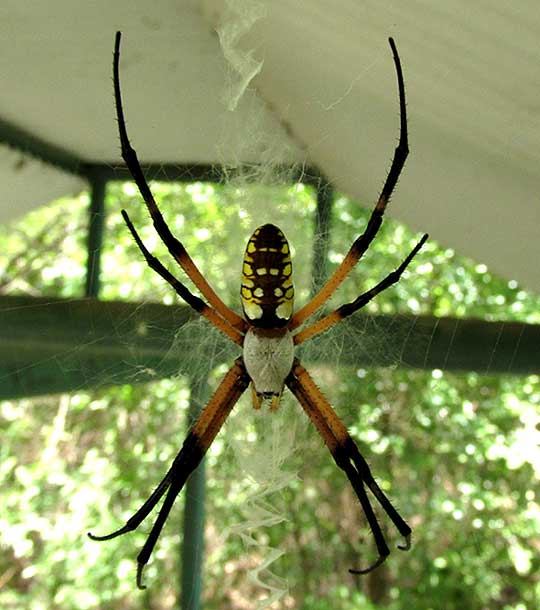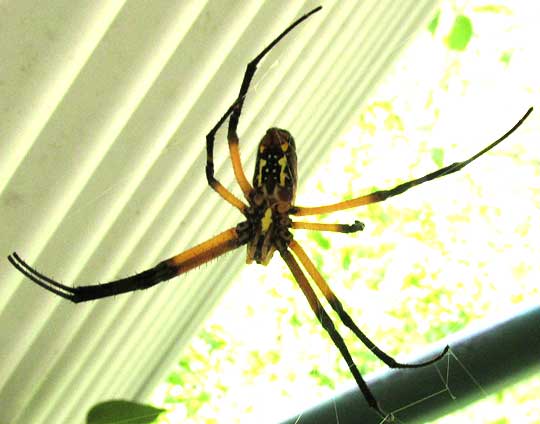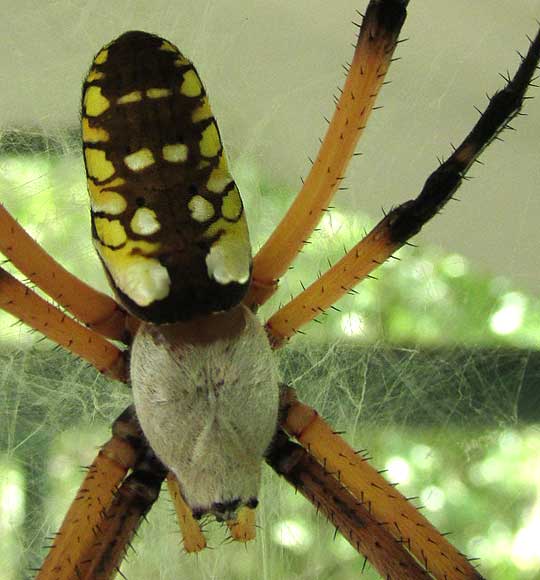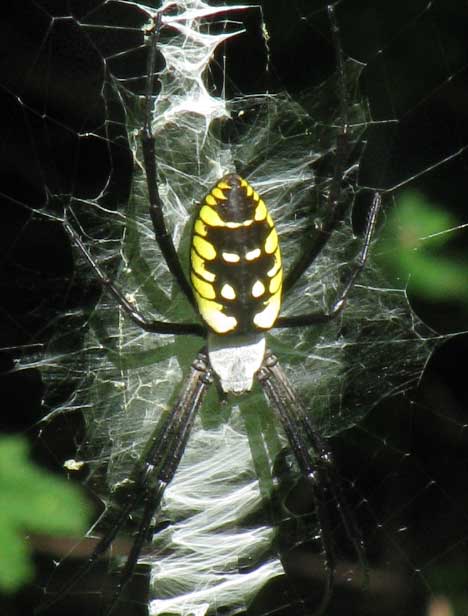Excerpts from Jim Conrad's
Naturalist Newsletter
from the August 10, 2014 Newsletter issued from the Frio Canyon Nature Education Center in the valley of the Dry Frio River in northern Uvalde County, southwestern Texas, on the southern border of the Edwards Plateau; elevation ~1750m (~5750 ft); N29.62°, W99.86°; USA
GARDEN SPIDER
Nowadays a large, common, conspicuous spider is showing up from southern Canada all through the US and Mexico into Central America. It's the Garden Spider, ARGIOPE AURANTIA, whose body measures about an inch long (25mm), with legs spreading across a much larger area. We've observed Garden Spiders nearly everywhere we've gone..
Garden Spiders occur here, too. Below, you can see one hanging in her web beneath a shelter at Cook's Slough Nature Park on Uvalde's south side:

If you closely compare that picture with the one featured in our next section, photographed in the Yucatan, you'll see subtle differences in color, patterning and body shape. For example, the one in the Yucatan has completely black legs, while the legs of our Cook's Slough one are yellowish at their bases. Most species with such extensive distribution areas display regional differences inspiring experts to define subspecies, or even to debate whether they might actually represent different species.
However, I can't find reference to our Garden Spider having subspecies. Still, I bet someone someplace someday will be glad to see photos of Garden Spiders from out-of-the-way places, so, below, I gladly post here a view of our Cook's Slough spider's undersurface:

And a close-up of the body, below:

from the August 29, 2010 Newsletter issued from Hacienda Chichen Resort beside Chichén Itzá Ruins, central Yucatán, MÉXICO
GARDEN SPIDER IN THE YUCATAN
These days up North in gardens and along roadsides often you see a really big, black-and-yellow spider suspended in the center of a large web with a conspicuous, white, zigzagging pattern of silk running vertically and passing beneath the spider. You can see such a spider over its zigzagging silk below:

That's a female ARGIOPE AURANTIA, so widely spread and conspicuous at this time of year that it goes by many English names, including Garden Spider, Writing Spider, Signature Spider, Banana Spider and Corn Spider. We have the same critter here, too, for the species is distributed from southern Canada through the US, Mexico and Central America.
The circular part of the female's web stretches about two feet across (60 cm) and the webs themselves usually are built between two to eight feet high. The zigzagging pattern of silk, called the stabilimentum, is variously thought to camouflage the spider or attract insect prey, but my favorite theory is that it's mainly to make it easy for birds to see the web so they won't destroy it by flying through it.
That's a female in the picture, her body minus legs being about an inch long (2.5 cm). The slender little brownish males are about a third as large. Males roam about looking for females and when they find one they may build their own much smaller web near or actually within the female's web, then court the female by plucking strands on her web.
from the August 12, 2001 Newsletter issued from the woods near Natchez, Mississippi
GARDEN SPIDER & WASPS
For a couple of weeks a large Garden Spider has taken over one corner of my outside kitchen. Males build smaller webs on the outer edges of the female's web. A couple of males are orbiting around my kitchen's big female as I write this.
I was very happy to see this Garden Spider in my kitchen. For one thing, she happened to build right next to a paper-wasp nest, the denizens of which had already plugged me several times.
Now, most paper-wasp species won't sting unless you really harass them, but around Natchez we have a species I never saw while living in Kentucky, and this one has caused me a lot of grief. It is amber-colored and it will sting even if you do no more than walk by, and it's a good sting, too, one that throbs for a long while. Usually as soon as I see this wasp's paper nests I remove them, for if they are left they'll be enlarged and soon support sizable colonies of stingers. However, the nest the spider was next to was inside a hollow giant bamboo holding up the corrugated tin sheets of my kitchen's roof, so I've been unable to remove it.
On the first morning of my new Garden Spider's occupancy she caught 7 amber-colored paper wasps, the next day 3, and during subsequent days she caught one or two each day. Now she's wiped out the entire wasp colony.
Actually, I have mixed feelings about this. For, the first summer I was here a small paper nest of these wasps was established right outside the screen window where I read in the evening. I could watch these wasps' every move from just a couple of inches away. For several weeks I watched the wasps enlarge their nest with more cells, and I watched as they cared for and groomed their newly hatched sisters with incredible dedication. When it was hot, they ventilated their nest by whirring their wings. How can you dislike any creature who works so hard and selflessly for its family?
Despite my ambivalence, I'm glad the Garden Spider has become my neighbor, and I'm glad she eats wasps.
from the September 2, 2001 Newsletter issued from the woods near Natchez, Mississippi
GARDEN SPIDER #2
Last Sunday I reported that the Garden Spider in my outside kitchen had disappeared. Monday morning I was amazed to find the web rebuilt, and in its center there was a new Garden Spider. This second spider makes a larger and better-built web than the old one, though the spider itself is considerably smaller than the first one.
I can't imagine how this has happened. Was this smaller spider just waiting until the older one disappeared? Had there been a fight, with the smaller spider winning? Did the Dewdrop Spiders sharing the old web somehow broadcast to the area that a good Garden Spider web location was available?
This is just one of those mysteries, any explanation of which just has to be amazing. The Dewdrop Spiders are still there. In this rain the new Garden Spider isn't catching much.
There are so many mysteries out there.